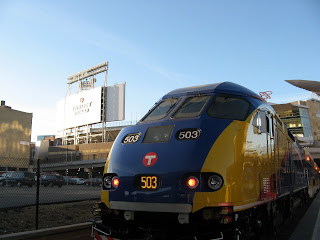On Monday, I got to take a preview ride of the new
Northstar Commuter Rail line from Minneapolis to Big Lake. For train geeks, the opening of the new line (it opens to passengers on Monday, Nov. 16) marks a hopeful new era for rail travel in Minnesota.
Practically, though, Northstar is about commuting to work...and not much more. The timetables are set to get people into Minneapolis in time to get to work and to get them back home shortly after work is done. Don't plan to stay downtown for a few drinks or a show because the last train out leaves at 6:10pm.
Nor should you expect to take a day trip from the city to beautiful Elk River. Downtown ER is a really nice place, with a great view of a meandering Mississippi River...but the Northstar station isn't anywhere near downtown. If you're daytripping, you'd better have someone ready to pick you up at the station.
All that said, Northstar will be great for thousands of commuters who want to avoid traffic on Hwy. 10 and relax a bit on the way to and from work.
My project is to create a podcast for people who ride the line to learn about the places they'll see along the way.
The corridor from Minneapolis to St. Cloud along the east side of the river is full of history: it was one of the main
oxcart trails to St. Paul from the Red River Valley from the 1820s to 1870s. Elk River housed the nation's first nuclear power plant. Big Lake was a major source of ice for Twin Cities ice boxes. Anoka is still home to Minnesota's first major mental health treatment center.
And of course there are the railroads. The Northstar runs along track laid by the St. Paul & Pacific Railroad in the 1860s. That track later became a key part of James J. Hill's Great Northern empire. Passenger trains ran along the line for over 100 years (actually, one still does: Amtrak's Empire Builder makes one run per day in each direction on its route from Chicago to Seattle). The rails are now owned by BNSF and that company's engineers will man the Northstar trains.
There are stories about American migration, agricultural and industrial development and our changing approach to living and working to be seen and heard on this train trip. I'm trying to compile those stories into a podcast that's both place-specfic and easy to digest. This isn't a lecture, it's a journey.
I hope the project will be done in the next couple weeks for any new riders of the line to enjoy. Because I critique a lot of podcasts here, I'm going to try to take a lot of my own medicine in the writing and producing. Wish me luck.
(Photos are mine.)
 This audio file is meant to be used on the train, starting at Target Field in Minneapolis. It's one 20 minute file, broken into 5 chapters...one for each station. At the end of each chapter, it asks listeners to pause the audio until they leave the next station. There's about 20 minutes of information in all for the 51 minute trip.
This audio file is meant to be used on the train, starting at Target Field in Minneapolis. It's one 20 minute file, broken into 5 chapters...one for each station. At the end of each chapter, it asks listeners to pause the audio until they leave the next station. There's about 20 minutes of information in all for the 51 minute trip.



















